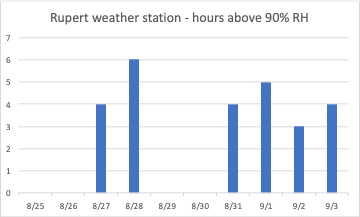University of Idaho Extension potato researchers issued the following report this morning for Idaho potato growers:
Phytophthora infestans (late blight) spores were detected at the spore trap in Paul, Idaho, close to the affected fields on Aug. 30 and 31. No other days or spore traps were positive over the past week.
Spores of Alternaria solani (early blight) were observed at Aberdeen (one day), Parma (five days), Acequia (three days), Blackfoot (one day), northeastern Owyhee County (one day) and the western Treasure Valley (one day).
Spores of Sclerotinia sclerotium (white mold) were observed at Parma (two days), Blackfoot (one day), Tetonia (one day) and Rexburg (one day).
Weather conditions do not seem conducive for late blight this week on the whole. The highest humidity levels we observed in the 15 weather stations we are monitoring across southern Idaho were at Rupert and Fort Hall. At these stations there were a number of days with several hours of humidity above 90 percent (see figures below), but conditions there are still likely to be below accepted thresholds for disease development. Most of the other weather stations monitored did not have any significant number of hours humidity above 90 percent.


Recommendations
Growers in the vicinity of Paul should remain vigilant for late blight disease, particularly if humidity levels increase or localized conditions have higher than normal humidity levels. Spores are still being detected in the immediate area of Paul, although they don’t appear to have traveled the 10 to 13 miles to the traps east of Rupert and at Acequia.
Further information and recommendations on late blight can be found here:
http://pnwpestalert.net/uploads/Late_blight_2019_outbreak_info.pdf
http://www.idahopotatodiseases.org/lateblight.html
https://millerresearch.com/research-library/late-blight/